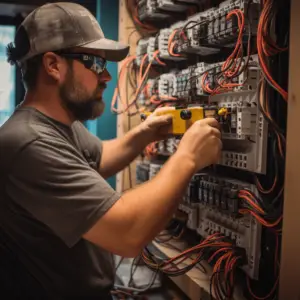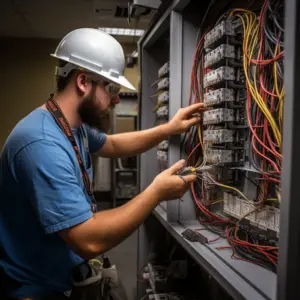Table of Contents
Introduction to Electrical Wiring
Electrical wiring is a must for modern life. Electrical Wiring powers homes, offices, and more. Knowing the basics is essential for homeowners, electricians, and builders.
Safety is always the number one priority when it comes to wiring. Insulation and grounding are key for secure functioning. Following local building codes and regulations will minimize hazards.
High-quality materials are important for an effective system. Choose durable wires with enough capacity. Using correct wire gauges and installing properly is vital.
Regular inspections and maintenance should be done to spot any issues before they become worse. Checking for signs of wear and tear, loose connections, or faulty components can help prevent accidents. Hire a licensed electrician for complex projects for safety.
Understanding the Basics of Electrical Wiring

Wiring is a key part of a system that works well. For the safe and effective distribution of energy in buildings, it’s important to know what it’s all about. If you know the basics, you can deal with electricity problems and make decisions based on what you need.
Also, you’ll need to know about the wires, switches, outlets, and circuit breakers that make up the system. Cables carry electricity, switches and outlets turn on and off machines, and circuit breakers stop the flow of electricity if something goes wrong. When electricians and individuals know how these parts work together, they have the confidence to handle electrical systems.
You should also know about the different kinds of wiring, such as non-metallic (NM), armoured (AC), and underground feeder (UF) lines. Each type is good for a different job, so it’s important to choose the right one.
Thomas Edison was one of the first people to work on methods for wiring electricity. In 1879, he tried to change the way cities used light by connecting incandescent lamps with copper lines. This discovery paved the way for modern systems and brought on the age of electric lights.
When we know the basics of how electricity works, we can use and manage power with ease. We can figure out how cables are set up and use that knowledge in different situations so that we can use energy safely and effectively. By taking the mystery out of this important part of life, we can move forward with electricity-powered prospects with more confidence.
Types of Electrical Wiring
Electrical wiring is an essential part of any building. It’s important to know the different types, to stay safe and efficient. They are:
- Knob and Tube Wiring
- Aluminum Wiring
- Copper Wiring
- Underground Wiring
- Non-Metallic Sheathed Cable (NM)
Plus, there are subtypes for special needs.
To make the best choice, consider cost, safety, codes, and usage. Knowledge of wiring types is critical for new installs, renovations, and repairs. It can help prevent dangerous electrical accidents.
Stay informed and stay safe! Have knowledge of wiring types – it’s an opportunity to protect yourself and your family. Get sparks of excitement in every room with cables, conduits, and components that bring power to our lives.
Components of Electrical Wiring System
An electrical wiring system, done right, has various components that work together for efficiency and safety. Let’s take a look at the table below to understand them better:
| Component | Description |
|---|---|
| Wires | Carry electric current from one to another. |
| Switches | Control the flow of electricity. |
| Outlets | Connect electrical devices. |
| Circuit Breakers | Protect against excess current and overloads. |
| Fuse | Melts when too much current flows. |
| Conduits | Provide insulation and physical protection. |
| Connectors | Securely join wires together. |
Plus, other essentials like junction boxes, grounding systems, and cable trays all work together to ensure a reliable electricity supply in any residential or commercial setting.
To maximize performance, here are some tips:
- Correct Wire Sizing: Prevents overheating and energy losses.
- Regular Maintenance: Identifies issues before they become bigger problems.
- Adequate Grounding: Protects against electric shock and power surges.
- Surge Protection: Safeguards electronic devices from voltage spikes.
Follow these suggestions to get the most out of your wiring system. Remember, a well-designed system with reliable components is key to an uninterrupted electricity supply.
Planning and Designing Electrical Wiring
It is important and takes skill to plan and build electrical wiring. It’s about making a safe and effective plan for the circuits in a building or structure. To do it right, follow these three steps:
- Assess building’s electrical needs: Look at how many and what kind of appliances/lighting/electrical devices are needed in each space. This will help decide the right capacity and load distribution.
- Make a wiring plan: Put outlets/switches/breakers on the diagram according to convenience, safety regulations, etc. Make sure there’s enough power for all areas, and no overloading.
- Quality materials and workmanship: Use wires/cables/conduits/fittings that meet safety standards. And hire licensed electricians who know proper installation. This ensures good performance and lowers the risk of accidents or malfunctions.
Also, consider local regulations and future expansion plans when planning and designing. Complying with rules and preparing for future growth helps prevent problems that might be expensive and unsafe. Invest time and money into this stage, and consult professionals to get the best results. Installing electrical wiring? Think ‘spaghetti of live snakes – but less hissing!’
Installation of Electrical Wiring
Electrical wiring is an essential part of any building. Installing and connecting electrical components for power distribution needs pro expertise. To do this safely and efficiently, follow six key steps:
- Planning & Design: Make a plan first. This includes assessing the building’s electrical needs, analyzing load requirements, and designing a wiring layout.
- Getting Materials: Gather all the required materials like cables, wires, junction boxes, etc.
- Switch off Power: Safety is a must. So, switch off the main power supply to avoid any shocks.
- Running Wires: Run wires through pathways, insulate them, and secure tightly.
- Connecting & Testing: Connect wires to outlets, switches, and circuit breakers. Then, test each circuit.
- Final Checking: Check all connections for accuracy before restoring power. Make sure there are no loose ends or hazards.
Keep in mind that each step needs to be done carefully. Professional knowledge is also needed for choosing the right wire sizes. Adhere to local regulations and safety standards. Hiring an electrician is the best way to make sure the job is done properly. Don’t risk your safety with electrical wiring. Troubleshooting can be tricky, so be cautious.
Troubleshooting and Maintenance of Electrical Wiring
For electrical wiring troubleshooting and maintenance, a professional approach is key. Here are some pointers:
- Inspections: Check wiring regularly to spot potential issues before they become big ones.
- Grounded: Electrical systems need to be grounded for safety and to prevent shocks.
- Identify hazards: Spot any hazards.
- Fix faults: A qualified electrician should fix faults or inconsistencies in wiring.
- Maintenance: Cleaning and tightening connections helps prolong wiring lifespan.
Also, keep up with new advancements in wiring technology to keep an efficient and safe electrical system.
The light bulb that Thomas Edison made changed how electrical wiring was done. It gave homes and companies all over the world reliable access to electricity. Without this smart person, we wouldn’t be able to fix problems and keep our wires in good shape today.
From knots to connections, electrical wiring technology has come a long way. It’s humanity’s ‘knot’ untangled!
Advancements in Electrical Wiring Technology

Revolutionary advancements in electrical wiring tech have totally changed the way we power our homes and businesses. These developments have increased safety, efficiency, and reliability.
| Advancements | In Electrical Wiring Technology |
| Improved Safety | Stronger insulation materials and up-to-date circuit breakers provide improved protection against electric hazards. |
| Enhanced Efficiency | Energy-saving tech, such as smart meters and LED lights, help optimize energy use and cut costs. |
| Increased Reliability | Modern wiring techniques and supplies guarantee a more dependable electrical infrastructure. |
These changes go beyond the small changes that are often made to electrical wire technology. They give people more control over how much energy they use, which helps the environment.
Electrical wiring has gone through a lot of changes over time. From simple copper lines to aluminium conductors, each time period had its own problems and successes. Electrical wiring is an important part of modern life because it is always changing as technology gets better.
Conclusion: Professional Assistance is Vital for Electrical Wiring Projects – Keep in mind, even the most daring DIY projects can electrify your life, but it’s best to leave the electrifying performances to the experts.
Conclusion: Importance of Professional Assistance in Electrical Wiring Projects
Professional help is necessary for electrical wirings projects. They guarantee safety and efficiency. Their understanding of regulations ensures compliance and cuts down risks. To stay safe, avoid DIY wiring.
Professionals use high-quality materials and tools. They also have access to advanced tech which helps them tackle any issues. This means your wiring project is completed quickly, with no disturbances.
In the long run, professional assistance saves money and time. Their expertise means they work fast without compromising quality. Hiring pros avoids trial and error, preventing costly errors. Invest in expert help to avoid repairs or replacements due to faulty wiring.
Secure your electrical wirings project with professional help. Reap the benefits of their knowledge, skills and resources. Trust the experts for peace of mind that your home or business is wired correctly and safely.


